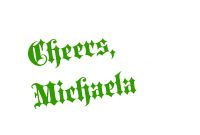Our first stop was in a little village named Chenonceaux (pronounced shun-nohn-soh.) This is a very popular tourist attraction in the Loire Valley so it was very crowded. I believe its the most visited chateau in all of France.
 |
| The pretty walk to the chateau from the parking lot |
 |
| Look at this HUGE leaf! |
Chateau Chenonceau dates back to around 1412 and was built on an old fortified mill. It was built and rebuilt several times due to fires or being destroyed. In 1535 King Francis I seized the chateau for unpaid debts to the Crown. After Francis's death is 1547, Henry II offered the chateau as a gift to his mistress, Diane de Poitiers. Diane became very attached to the chateau and she had the arched bridge built to join the chateau to the opposite side of the river. She planted flower and vegetables gardens.
The ownership of the chateau remained with the crown until 1555 and Diane de Poitiers took legal matters into her own hands and was given possession of it. However, after King Henry II died in 1559, his widow Catherine De Medici forced Diane to exchange it for the Chateau Chaumont (which we visit after this). Queen Catherine made this chateau her own favorite residence and added many gardens.
 |
| This is the entrance into Chateau de Chenonceau. You cross over three moats and two bridges to get into the castle. We told L that Rapuzel lives in the old round tower! |
 |
Many of the fireplaces were lit in the rooms..so cozy. This
was the fireplace in the guards room that protected the castle. |
 |
| This is the original colorful floor |
This was Diane de Poiters bedroom. After Queen Catherine kicked the mistress out she hung her portrait over the fireplace and she never used this bedroom. There are many many tapestries in this chateau. They were used to cover the walls and keep the rooms warm.
 |
|
This is the chapel in the chateau. It survived the vandalism of the Revolution because they filled it with firewood. The windows were blown out during WWII and were replaced in the 1950's.
 |
| Chapel |
The is the long 200 ft gallery that spans the length of the river. The floor is slate and limestone. They had grand banquets here. Queen Catherine threw big parties here and employed her ladies to circulate and soak up all political gossip possible. They even had fireworks and mock naval battles on the river. The niches once held statues but Louis XIV liked them so much he moved them to Versailles. In WWI, the Gallery served as a military hospital, where more then 2200 soldiers were cared for. During WWII the river here marked as a borker between the Vichy government and the Nazi-controlled France. There were many prisoner swaps at the chateau.
 |
| The Gallery |
 |
| This was the ceiling in Catherine's study |
This was part of the multi room kitchen. They had a pantry, their own dining room, and cooking room. In the 16th century this was a state of the art kitchen. It was built near the water to fight off fires in the kitchen. There was a landing bay so that goods could come in and go out without disturbing the guests.
 |
| The kitchen |
 |
| Landing Bay |
This staircase that went upstairs wowed the royal guests. It was the first non-spiral staircase they had seen. The balcony has lovely views of the gardens.
 |
| This is Louis XIV Living Room, which commemorated his visit in 1650. |
This was called the Five Queens bedroom in honor of Catherine de Medici's two daughters and three daughters-in-law: Queen Margot, Elisabeth of France, Marie Stuart, Elisabeth of Austria and Louise de Lorraine.
 |
| Five Queens' Bedroom |
 |
| Catherine de Medici's Bedroom |
 |
| King Henry and Queen Catherine's initials on the ceiling |
 |
| View out of one of the windows |
 |
| The was Cesar of Vendome's room, son of King Henry IV and Gabrielle d'Estrées, who became owner of Chenonceau in 1624. |
 |
| Louise of Lorraine retired to the Chenonceau after the assignation of her husband, King Henry III. She spend the rest of her life in meditation and prayer in this room. The walls and ceiling and are all black. |
 |
| Aerial view of the chateau grounds |
 |
| Chateau Chenonceau |
 |
| View of the Gardens |
 |
| Chancellery House where the estate steward lived. |
 |
| Buildings from the 16th century farm |
 |
| Getting a quick lunch..why of course a French Baguette! |



































No comments:
Post a Comment
Say hello - I'd love to hear from you!